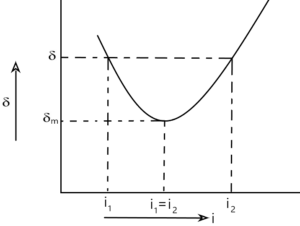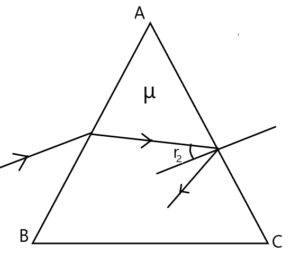Refraction through prism (introduction)
hhh
PRISM
A prism is a portion of a transparent medium bounded by two plane faces inclined to each other at a suitable angle.

TERM ASSOCIATED IN PRISM
(a) Angle of prism:- The angle of a prism or the refracting angle of a prism is the angle between the plane on which light is incident and the plane from which light emerges.
(b) Incidence angle:- It is the angle that the incident ray makes with the normal to the plane where the ray first strikes the prism.
(c) Emergence Angle:- It is the angle that the ray that emerges out of the prism makes with the normal to the plane where the ray exit the prism.
(d) Angle of deviation:- It is the angle between the emergent ray and the incident ray. Generally, it is denoted by

CALCULATION OF ANGLE OF DEVIATION

Let ABC is a prism with angle A. A ray of light PQ is incident on the face AB of the prism at an angle . It bends towards the normal with a refraction angle
. The refracted ray QR is incident at face AC with an angle
. It bends away from normal with a refraction angle
.
From fig. is the angle of deviation.
In quadrilateral AQNR
from (a) and (b)
from (1)
Thus, the angle of deviation depends on the angle of incidence.
Let is the refractive index of prism.
using Snell’s law for face AB
for small angle
Similarly for face AC
we know that
NOTE:- When the refracting angle of the prism is small () formula (B) is used for finding the angle of deviation, otherwise formula (A) is used.
PRISM FORMULA
We know that the angle of deviation depends on the angle of incidence (i) as
when i is increased, first decreases, reaches a minimum, and increases again.

for one value of, there are two angles of incidence . This is because “When the direction of the light ray is reversed, the ray simply retraces its path. This statement is called the principle of Reversibility of path of light“
i.e, if the ray is reverse, the angle of incidence is and angle of emergence is
and then the angle of deviation is the same
in minimum deviation,
we know that
also,
using Snell’s law for face AB
This is the prism formula. This is used to determining R.I of the material of the prism.
NOTE:-
1. Angle for maximum deviation:-
we know that
is maximum when incidence angle (i) is maximum. And the maximum value of i is
2. Condition for no emergence:-(MAYBE IGNORE THIS PORTION)

From fig, if the ray does not emerge from face AC, this will happen only when TIR occurs for a glass-air interface.
Now is maximum when
is maximum and we know that maximum value of
from (1)
Now TIR will happen, when
Obviously, 100% TIR will occur, when
When the angle of the prism is twice the critical angle for the material of the prism, the emergent angle is totally internally reflected and not emerged out.
IMPORTANT QUESTIONS FOR PRACTICE
1. A prism is made of glass of unknown refractive index. A parallel beam of light is incident on the face of the prism. The angle of minimum deviation is measured to be . What is the refractive index of the material of the prism? The refracting angle of the prism is
. if the prism is placed in water (R.I=1.33), predict the new angle of minimum deviation of a parallel beam of light.
